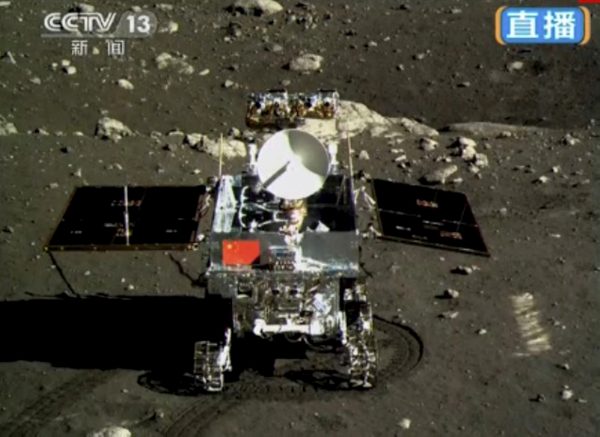By Junzhi Song
Copyright thediplomat

China’s space program has followed a deliberate, methodical trajectory that blends technological ambition with geopolitical foresight. From the Chinese Lunar Exploration Program (CLEP) – also known as the Chang’e Project – and the Tiangong space station to the Tianwen-1 Mars exploration program, China has steadily expanded both its technical capabilities and international visibility. These efforts reflect more than scientific curiosity. They are strategic instruments that project national power, bolster domestic legitimacy, and cultivate soft power globally – all key components of Xi Jinping’s vision to turn China into a “great space power.” China does not separate civilian and military space operations. The People’s Liberation Army (PLA) oversees all major infrastructure, from launch facilities such as the Jiuquan Satellite Launch Center and Wenchang Space Launch Site to telemetry, tracking, and control (TT&C) networks. This integration ensures that technological advancements serve dual-use purposes, spanning interplanetary exploration and anti-satellite capabilities. China’s civil-military fusion has positioned the country to influence emerging norms and standards in space exploration. Its ambitions are not confined to low Earth orbit or lunar missions; China envisions itself as a leader in deep-space governance, shaping the rules for asteroid mining, orbital traffic management, and international collaboration. In doing so, it challenges the U.S.-led framework, particularly initiatives such as the Artemis Accords, which emphasize transparency, open collaboration, and rules-based governance. Space, Nationalism, and CCP Dominance in China Space power is no longer viewed solely as a technological achievement but as a core symbol of national strength and global influence, closely intertwined with nationalism and Communist Party dominance in China. China’s ambition to transform itself from a “major space power” into a “great space power” reflects the central role of technology in building comprehensive national power. Since the founding of the People’s Republic, Chinese leaders have described science and technology as the “first productive force,” linking technological innovation to both economic modernization and national security. In recent years, President Xi Jinping has explicitly framed the country’s space program as part of a broader “Space Dream,” portraying it as a powerful force for national rejuvenation. This techno-nationalist vision also drives China’s institutional and industrial engagement. Through partnerships with developing nations, China signals its aim to set standards and shape governance norms in the emerging space order. By reducing foreign dependence and dictating technical standards, this approach positions China as a global leader and an alternative to U.S.-led frameworks. Reinforcing this strategic and technological agenda, military-civil fusion forms the foundation of China’s space rise, with the People’s Liberation Army overseeing key launch sites such as the Wenchang Space Launch Site and managing tracking and telemetry networks. This integration blurs civilian and military boundaries, enabling technologies like reusable launch vehicles, in-orbit refueling, and cislunar logistics to serve both strategic defense and scientific exploration, positioning China to sustain operations beyond Earth while challenging U.S. dominance in the cislunar domain. China’s space narrative further fuses nationalism with cultural symbolism, with names like “Chang’e,” “Tiangong,” “Tianwen,”and “Long March” evoking mythology, literature, and revolutionary history. By portraying space achievements as collective victories of a state-led system, the Communist Party reinforces its legitimacy and central role in national rejuvenation. Space is framed as the strategic high ground of the 21st century, signaling China’s ambition to challenge U.S. leadership and shape the rules and power structures of outer space. Grasping China’s historical trajectory is key to making sense of its latest moves on the international stage, particularly the launch of the International Deep Space Exploration Association (IDSEA). IDSEA: Launching a New Space Order The July 7, 2025 inauguration of IDSEA in Hefei, China, signaled Beijing’s growing ambition to steer the rules of deep-space exploration. The new organization has significant state backing: China National Space Administration (CNSA), the Ministry of Civil Affairs, the Anhui provincial government – the association is headquartered in Anhui Province – are all involved with IDSEA, and the China Association for Science and Technology participated in the founding event. IDSEA positions itself as a global coalition dedicated to advancing humanity beyond low Earth orbit, providing a platform where national space agencies, scientific institutions, and private aerospace companies collaborate on the technical and logistical challenges of deep-space missions. Michel Blanc, chairman of the French Planetary Exploration Horizon 2061, described IDSEA’s establishment as “an important event in the development of global cooperation in deep space exploration.” IDSEA is structured to balance scientific objectives, geopolitical considerations, and commercial interests. Its membership spans national space agencies, academic institutions, international organizations, and private firms, with a rotating council designed to mediate competing priorities and ensure diverse perspectives inform planning for lunar, Martian, and deep-space initiatives. Comprised of Chinese institutions – including the Deep Space Exploration Laboratory (DSEL), the Lunar Exploration and Space Engineering Center (LESEC), the Chinese Society of Astronautics (CSA), and the Chinese Society of Space Research – IDSEA also counts international partners such as France’s Planetary Exploration Horizon 2061. Beijing’s space push has already secured endorsements from the United Nations Office for Outer Space Affairs (UNOOSA), the International Astronautical Federation (IAF), and a wide circle of government agencies, research institutes, and universities worldwide – signaling that China is not just building coalitions but carving out legitimacy as a global leader in deep space. Engines of Exploration: Technology, Collaboration, and Public Trust IDSEA pursues ambitious technological and scientific objectives. Key priorities include propulsion systems for interplanetary missions, life-support systems for long-duration flights, and deep-space communication infrastructure. Joint missions allow participating nations to share payloads, coordinate lunar experiments, and pool observational data, reducing duplication and increasing efficiency. Collaborative technology development in areas such as radiation shielding, autonomous robotics, and asteroid resource extraction may accelerate capabilities across the coalition. Public outreach forms another pillar of IDSEA’s mission. STEM initiatives aim to cultivate the next generation of engineers and scientists while sustaining political and societal support for expensive space programs. By emphasizing education and transparency, IDSEA seeks to cultivate a constituency that values long-term collaboration over short-term geopolitical gain, framing China as a responsible leader in space despite underlying strategic motives. Structural and Geopolitical Challenges Despite – or perhaps because of – its ambitions, IDSEA faces challenges, ranging from the mundane (funding constraints and coordinating between diverse entities) to the geopolitical (duel-use risks and inclusivity). Deep-space missions are inherently costly, requiring sustained investment over decades. Divergent priorities among governments – China, the U.S., Russia, the EU, and smaller spacefaring states – can strain cooperation. Strategic competition, conflicting national interests, and covert military objectives could delay or block critical decisions, highlighting the persistent tension between cooperation and competition in space governance. Smaller or emerging space nations may struggle to influence governance or agenda-setting, raising questions of fairness and inclusivity. China’s prominent role heightens these concerns, as it can leverage dual-use capabilities and technological leadership to shape norms and standards, potentially consolidating long-term strategic advantages. China’s integration of civilian and military programs means that scientific collaboration carries inherent strategic risks. PLA oversight of launch sites, mission control, and telemetry networks raises questions about transparency and intent. Technologies designed for research – rendezvous systems, orbital debris mitigation, propulsion innovations – can serve dual-use purposes, from satellite servicing to anti-satellite operations. Dual-use concerns extend to satellites capable of proximity operations, rocket stages adapted for commercial payloads, and intellectual property. Insufficient oversight could deter countries from contributing high-value technologies while exposing sensitive capabilities to potential exploitation. IDSEA’s governance model faces significant hurdles. Ensuring equitable participation requires transparency, binding decision-making frameworks, and mechanisms for dispute resolution. Without these safeguards, dominant actors – primarily China – could impose agendas that compromise trust. The initiative also risks fragmenting the broader international space regime by creating parallel frameworks that may conflict with U.N. guidelines and other multilateral standards. Fragmentation could stall missions, slow scientific progress, complicate coordination, and weaken shared norms around resource management, orbital traffic, and demilitarization. Commercial priorities compound these challenges. State-backed Chinese companies, benefiting from domestic support and preferential access to resources, are well-positioned to dominate IDSEA-linked contracts and infrastructure. Such dominance risks crowding out international competitors, distorting emerging markets, and consolidating strategic advantages. Without rigorous oversight, the distinction between civilian collaboration and strategic gain may be obscured, allowing IDSEA to operate simultaneously as a platform for scientific partnership and as a vehicle for geopolitical influence. Broader Geopolitical Implications: Cooperation and Competition IDSEA signals China’s ambition to become a central node in the architecture of space governance, with consequences for the U.S., the European Union, and other international actors. Countries participating in IDSEA-linked missions risk aligning with Chinese norms and standards, potentially diverging from broader international frameworks or established commercial best practice. Such alignment could foster long-term strategic dependencies or asymmetries, particularly if China leverages its technological lead to extract concessions in space and terrestrial affairs. IDSEA embodies the dual nature of deep-space collaboration: it promises collective progress while introducing persistent risks of strategic rivalry. China’s civil-military integration, control over dual-use infrastructure, and capacity to dominate emerging markets heighten concerns over transparency, equity, and trust. The trajectory of deep-space cooperation will depend less on technological breakthroughs than on the political will, vigilance, and coordination of the global community. The gravitational pull of China’s cosmic strategy is undeniable. IDSEA may accelerate technological progress, pool expertise, and broaden participation, yet it simultaneously risks creating new fault lines in space governance. If deep space is to remain a shared arena for humanity rather than a theatre for great-power competition, transparency, accountability, and strategic foresight will be indispensable. The international community faces the delicate challenge of engaging, observing, and collaborating without ceding strategic control, ensuring that exploration advances both science and collective security.



